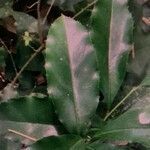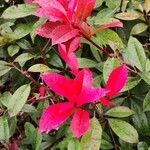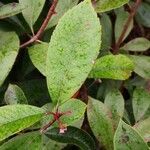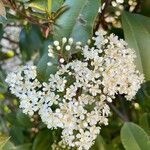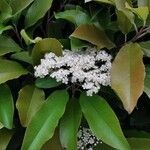Shrubs or trees, evergreen, 4–6(–12) m tall. Branchlets brown or reddish brown when young, brownish gray when old, glabrous; buds ovoid, 4–7 mm, apex acute to shortly acuminate; scales several, brown. Petiole 2–4 cm, pubescent when young, glabrescent; leaf blade narrowly elliptic, narrowly obovate, or obovate-elliptic, (6–)9–22 × 3–6.5 cm, leathery, veins 20–30 pairs, midvein raised abaxially and impressed adaxially, abaxially long pubescent along veins when young, both surfaces glabrous when mature, adaxially lustrous, base rounded or broadly cuneate, margin sparsely or inconspicuously toothed or entire, apex acuminate. Compound corymbs terminal, 8–12 × 10–16 cm; rachis and pedicels glabrous, villous, or tomentose. Pedicel 3–5 mm. Flowers 6–8 mm in diam. Hypanthium cupular, 1–1.5 mm, abaxially glabrous. Sepals broadly triangular, 1–1.5 mm, apex acute or obtuse. Petals white, suborbicular, 3–4 mm in diam., glabrous or villous. Stamens 20, outer ones longer than inner ones. Ovary pilose apically; styles 2, sometimes 3, connate at base, not exceeding stamens; stigma capitate. Fruit red when immature, brownish purple when mature, globose, 5–6 mm in diam., with 1 seed; seeds brownish, ovoid, 2–2.5 mm, smooth. Fl. Apr–May, fr. Sep–Oct.
Plants 40–60(–120) dm. Leaves persistent; petiole 20–40 mm, villous adaxially when young, glabrescent; blade narrowly elliptic to oblong, obovate-elliptic, or narrowly obovate, (6–)9–20 × 3–6.5 cm, coriaceous, base rounded or broadly cuneate, margins sharply serrate to rarely inconspicuously toothed or entire, lateral veins 20–30 pairs, apex acuminate, abaxial surfaces slightly villous along veins when young, quickly glabrescent. Inflorescences 10–18 cm diam. Pedicels without lenticels. Flowers 6–8 mm diam.; petals suborbiculate, 3–4 mm, glabrous or villous.
A shrub.
